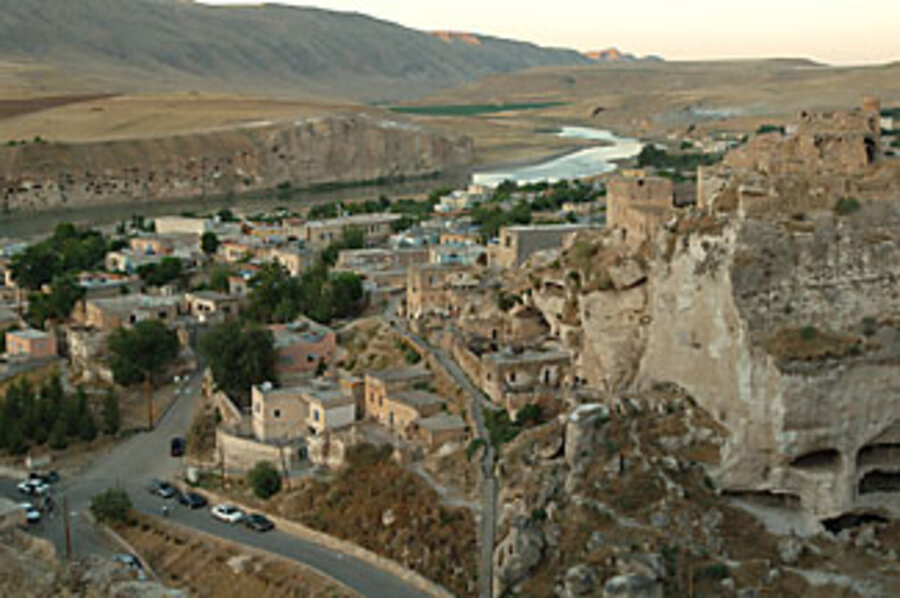Turkey revives stalled $32 billion GAP dam and irrigation project
Loading...
| Hasankeyf, Turkey
Set in a dramatic gorge on the Tigris river, Hasankeyf's ruins date back to Assyrian, Roman, Byzantine, and Ottoman times. But a massive dam and irrigation project could submerge the whole town.
On Tuesday, some 80 years after Kemal Ataturk, the founder of modern Turkey, first proposed tapping the storied Tigris and Euphrates for energy, the government will unveil plans to complete the stalled Southeastern Anatolia Project (GAP). The $32 billion project is intended to both provide Turkey with much-needed electricity and to pacify the restive Kurdish southeast, where rebels have capitalized on residents' economic grievances to build support.
But for locals and experts alike, big questions remain about GAP's effectiveness and whether it will be the magic bullet that lifts the southeast out of its long-standing economic and political troubles.
"The real problem with the project is the way it is being run.... Primarily what they did is an engineering project," says Ali Carkoglu, a political science professor at Istanbul's Sabanci University. "They are so preoccupied with conquering the geography that they are forgetting the more human issues," such as giving villages running water or developing local industry.
At least until now, GAP's achievements have made a bigger impact outside the southeast region. While the completion rate for hydroelectric projects, which mostly benefit western Turkey, is approximately 85 percent, the rate for irrigation projects, which are designed to boost agriculture in the arid southeast, is 24 percent.
And a recent study by the Turkish Confederation of Young Businessmen found that despite GAP's $20 billion investment in the southeast over the last two decades, the region's share of the national income is lower today than it was 40 years ago.
Mehmet Acikgoz, GAP's regional director, admits that irrigation had been previously neglected, mostly because of a lack of funding. But, he says, the project is now being approached with a renewed focus.
"One of the project's aims, especially, is to answer the social and economic problems in the region," Mr. Acikgoz said during an interview in his office, outside the southeastern city of Sanliurfa. "This region has a lot of potential. It has land, water, a young population, and this project is trying to bring out that potential."
For example, along with infrastructure projects, GAP also funds a number of social and economic development projects. In Sanliurfa and 28 other cities, the project supports community centers that offer childcare and educational courses for disadvantaged women.
Still, what is spent on projects like these is only a fraction of what GAP spends on dams and roads. Observers say that imbalance needs to be remedied if the restive Kurdish region is to be pacified.
"If the state doesn't take any steps towards solving the [ethnic] problem here both economically and politically, the problem will only get bigger," says Mehmet Kaya, president of the Diyarbakir Chamber of Commerce and Industry.
Adds Professor Carkoglu: "Unless economic development is coupled with more substantial reforms on political and cultural grounds, economic reforms will not be sufficient.... Finishing the GAP project with a few billion dollars will still not do it."
For his part, GAP regional director Acikgoz sees no "ethnic problem" in the southeast.
"The only problem in this region is economic," he says.
In Hasankeyf, though, strong skepticism remains about whether GAP will be able to remedy the area's ills – economic or otherwise.
"Of course this project will improve Turkey's economic situation, but it won't have a positive impact on the lives of the people living here," says the town's mayor, Abdulvahap Kusen.
"If GAP was really improving the region, we should have already seen its impact. We still haven't seen an improvement here compared to other regions in Turkey."
As the waters of the Tigris flow swifly by him, soon-to-be restaurateur Edip Ipek says he doubts whether the $1.8 billion Ilisu dam that will be built 50 miles downstream will bring a better future for his town. "They are promising us that we will all be able to work in fishing after the dam is built and that there will be tourism," he says. "But how many of us can work in fishing?"


